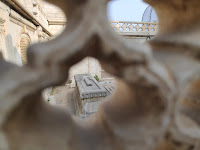Jahaz Mahal (in Urdu language ‘Jahaz’ means "Ship" and ‘Mahal’ means "Palace", the "Ship Palace"), is located next to Hauz-i-Shamsi in Mehrauli, Delhi on its northeastern corner. It was so named, since its reflection (illusion) in the surrounding reservoir looked like a ship floating on a lake. It is inferred to have been built during the Lodi dynasty period (1452–1526) as a pleasure resort, Sarai or an inn.
.
The graves in the precincts of Zafar Mahal, built within a marble screen enclosure by Jahandar Shah for his father Bahadur Shah I and others who followed, is a minor reflection of the history of the place. Shah Alam II who had the misfortune of being blinded by Ghulam Qadir, the Rohilla leader was buried here. He was considered a "puppet ruler", first under the Marathas and later under the British. His son Akbar II was also buried here. Mirza Fakruddin son of the last emperor Bahadur Shah Zafar, who died early ushered the end of the Moghul regime, was also buried here. But Bahadur Shah Zafar who had identified the location for his grave (sardgha – the vacant land for burial) was the most unfortunate (ill fated) as he was deported to Rangoon and was buried there.
Adham Khan's Tomb is the 16th-century tomb of Adham Khan, a general of the Mughal Emperor Akbar. He was the younger son of Maham Anga, Akbar's wet nurse thus also his foster brother. However, when Adham Khan murdered Akbar’s favourite general Ataga Khan in May 1561, Akbar immediately ordered his execution by defenestration from the ramparts of the Agra Fort.
The tomb was built in 1562, and lies to the north of the Qutub Minar, Mehrauli, Delhi, immediately before one reaches the town of Mehrauli, it is now a protected monument by Archaeological Survey of India- but is in a very poor state of maintenance. The tomb is opposite Mehrauli bus terminus and many passengers use it as a place to wait.
Moreover, because of the constant threat of Mongol invasion, almost all structures of that period, including mosques, had a military character such as tapering walls and turrets surmounted by crenellated parapets. The result is a unique mosque that looks like a fortress, or qila.
This monument is well preserved and we were happy to find an alert security guard placed there by ASI to safeguard it.






















